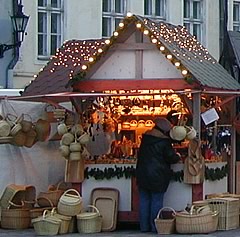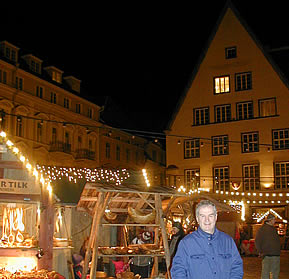

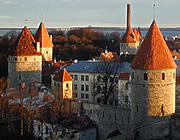
Our third Christmas Market trip and the second to the Baltic States. We loved Tallinn, a beautiful medieval town full of life with cobbled streets, lovely buildings and some of the best city walls we've seen anywhere.
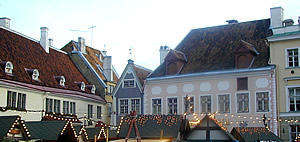
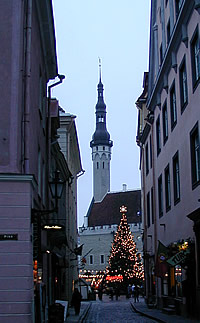
We arrived late morning so after a quick check-inat the Merchant's House Hotel we went to find lunch. Estonian pancakes at Kompressor which were rather thicker than I like - I guess I should have known from the Rough Guide description "wonderfully stodgy and filling".
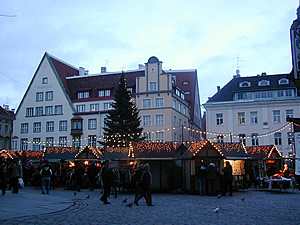
We then spent the afternoon wandering around getting to know the Old Town. The Town Hall Square is very close to the hotel, full of Christmas Stalls, and in all our wanderings we must have crossed it dozens of times, it seems all streets in Tallinn lead here. Needless to say that the hot wine sellers did well by us.
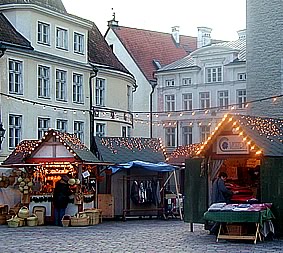
The Square dates from the founding of the city in 1219 by the Danish King Valdemar II. He built a castle and cathedral on the rock known as Toompea and the town soon started to grow at its foot.
Dominated for centuries by Germanic settlers, the Estonians were very much regarded as second class citizens. Tallinn was one of the most important Hanseatic trading cities - the Hanseatic League being the German-dominated group of Baltic trading cities. Historically this is Tallinn's most important and wealth-providing function and the city was a focus for traders and merchants.
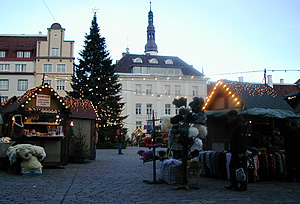
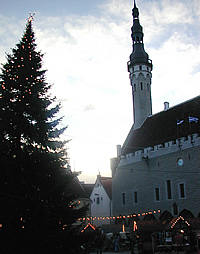
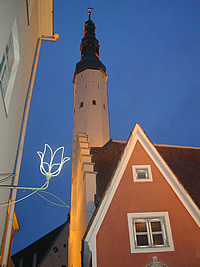
In rebellion the native Estonians enthusiastically adopted Protestanism in the early sixteenth century and riots destroyed much of the medieval religious art. The city was fought over in the mid-sixteenth century by the Russians and Swedes and these wars affected trade badly. The Swedes emerged victorious but in turn were thrown out by Peter the Great in 1710.
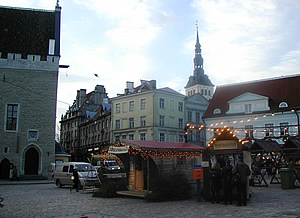
In the nineteenth and twentieth centuries industrialisation led to an influx of Estonians into the city from the countryside. In 1991 Estonia finally became independent.
The Gothic Town Hall in the square would have been the centre of activities during Tallinn's Hanseatic era. On the steeple is the Old Thomas weather vane which is associated with a local legend about a boy who beat the German-speaking aristocrats at an archery contest in the Parrot Garden outside the city walls.
Another very old building in the north east corner, dating from at least 1422, is the Town Pharmacy (Raeapteek), with a smart seventeenth century facade. It still operates as a pharmacy, and has a display of old pharmacy artefacts too.
A small passage next to Raeapteek leads to the Church of the Holy Ghost, a Gothic church, little changed from the fourteenth century, apart from the addition of a Baroque bell tower. The clock on its front wall is the oldest public timepiece in Tallinn.
West of the square on Rataskaevu we had an excellent meal at Vanaema Juures (Grandma's Place). I had herring (love it!) followed by elk - a first for me, very solid, gamey and quite dry meat, a bit like pheasant. Andrew had excellent beef fillet.
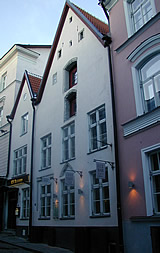 Merchant's House Hotel
Merchant's House Hotel
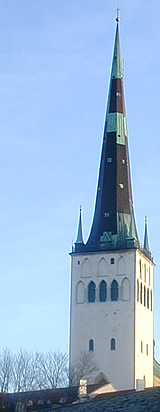 St. Olaf's Church.
St. Olaf's Church.North of the Old Town Square Pikk tänav (long street) stretches south-west to north east. Our hotel was on a small street between the Town Hall Square and Pikk. We had the Sanctuary Suite, very modern furnishings and loads of space. One of the best things about the hotel was the ice bar, blue-lit and quite extraordinary. We had vodka shots here several nights before dinner: lemon, lime , raspberry - all kinds of flavours, all excellent and served in ice shot glasses. We also ate at the restaurant in the hotel and found the food very good: I had confit of rabbit with warm potato salad and Andrew cappaccio of beef with foie gras (though this was far too creamy and quite sickly) to start, then excellent rack of lamb followed by crème brulée - very acceptable.
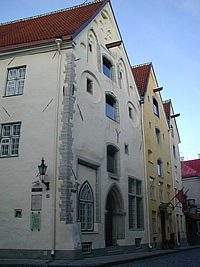
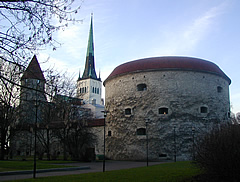
Northish of the hotel is Pikk and the Great Guild. Built in 1430 this guild was reserved for the most prosperous, essentially the German-speaking elite. Lesser guilds catered for the more modest Estonian merchants and craftsmen. Further north along Pikka is the House of the Blackheads - as in Riga a guild for visiting bachelor merchants. In Tallinn they also organised defence detachments.
St. Olaf's Church has a very tall spire, which used to be even taller. It was so tall that the church burned down eight times between 1625 and 1820 as a result of lightning strikes.
Just before the Great Sea Gate which marks the northern end of Pikka are three of the best-preserved Hanseatic buildings in the Old Town. The Three Sisters are gabled merchants' houses with all the trappings of home, warehouse and office.
The sixteenth century Great Sea Gate is flanked by two towers of which the barrel-shape Fat Margaret has walls 4m thick and well-deserves its nickname!
The Parrot Garden, just outside the walls, was the scene of a contest for the German-speaking aristocrats in medieval times. It involved shooting a wooden parrot on top of a pole with a bow and arrow. Legend says that a young boy, Thomas, was very successful at this sport. Unfortunately he was from a poor family and could not receive a prize for the great skill he had shown. Instead he was made town guard for life. When he died a metal statue of him was erected on the Town Hall weather vane and the people believe that as long as Old Thomas remains in his place, watching over the city, no harm will come to it.
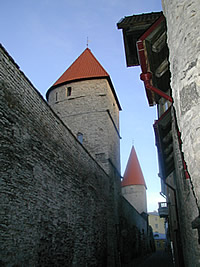 Northern section of wall along
Laboratooriumi
Northern section of wall along
Laboratooriumi 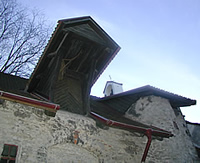
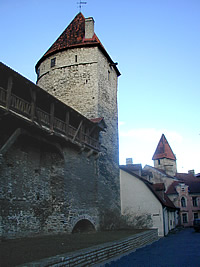
The most amazing thing about this city are its walls, long stretches still very much intact and dating from the Middle Ages. We followed them as far as we could, a western stretch south from the Great Sea Gate, a shorter southern stretch near Kiek-in-de-Kök (an eighteenth century bastion, the name means "peek into the kitchen") and a rather longer eastern stretch. It was a good way to see not only the magnificent walls but also parts of the town which aren't generally on the standard tourist trail.
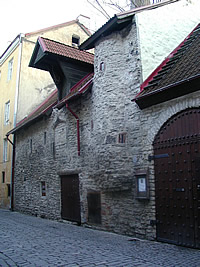 Church to the Blessed Virgin with Three Hands
Church to the Blessed Virgin with Three Hands
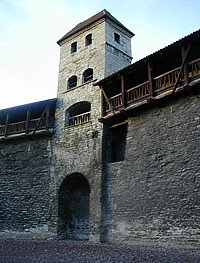 Southern section of wall
Southern section of wall
The walls originally date from the 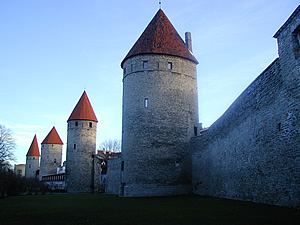 fourteenth century and were added to over the years until the eighteenth century.
fourteenth century and were added to over the years until the eighteenth century.
Below the walls in the northern part at Laboratooriumi 22 is the Ukrainian Church to the Blessed Virgin with Three Hands. According to a multi-lingual posting on the wall she is the protector of the innocent who have been wrongly convicted, deceived and sinned against. If you have a problem you can tell the priest by putting a letter in the box on the wall and he will pray for you.
In the southern section of wall there are three towers connected by a rampart, all of which can be climbed - very steep and dark!
We climbed to the top of Kiek-in-de-Kök - lots of cannon, and a model of a plague doctor in full black dress, crystal eye pieces and a mask with a long snout to fill with aromatic herbs. Also an evil-looking torture rack!
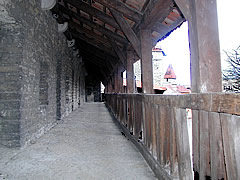
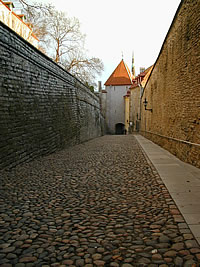
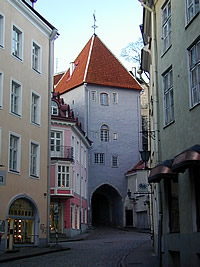
The high ground called Toompea to the west of the city is crowned by the Lutheran and Alexander Nevsky Cathedrals. The town seems to have been effectively divided in medieval times, church and state outside the walls on Toompea while inside the walls merchants and commercial activities dominated.
We climbed up several times along Pikk Jalg, a very picturesque cobbled street, the name of which means Long Leg.
The views from the top of Toompea over the town to the Baltic are excellent.
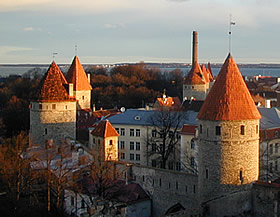
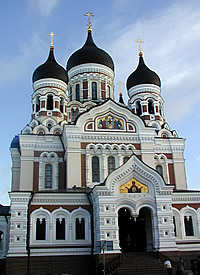
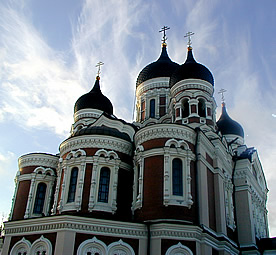
At the top of Pikk Jalg is Lossi Plats - Castle Square - and the gleaming Russian Orthodox cathedral which was built in 1900, as much a symbol of Russian supremacy as a place of worship. Against the sky its onion domes are strikingly beautiful.
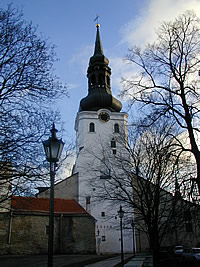
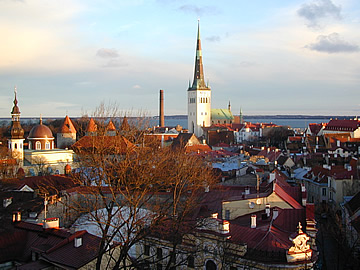
Further on is the more modest Lutheran cathedral, but appealing in its simplicity. A church has stood on this spot since the Danes first established their settlement here in 1240. Inside is a monument to a Scottish Admiral of Russian ships, honoured by Catherine the Great.
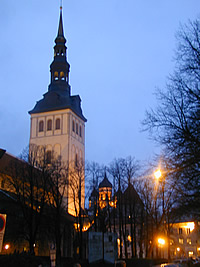
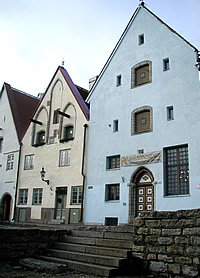
Back down in the Old Town we visited St Nicholas Church, originally thirteenth century but now mostly fifteenth. Inside are quite a few medieval artworks, the most remarkable of which is a very macabre "Dance of Death" by Berndt Notke.
There is also a celebrated late Gothic tryptich on the "Altar of the Blackheads" though the information for this in our guide book and the church differed as to whether St. Maurice or St. Victor is depicted with St George alongside the Madonna. It ought to be St. Maurice, the patron saint of the Blackheads, but he was a black Roman officer, the one shown appears to be white. Like many of the works of art in the church this was saved by hiding it first from Protestant rioters in 1524 and then again during the Second World War.
Not far from the church are more excellent examples of medieval merchant houses.
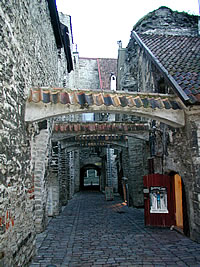
Tracing the city history, the City Museum on Vene is as interesting for the building it is housed in, originally a thirteenth century merchant's house which, like most buildings in the city, has been added to and restored over time.
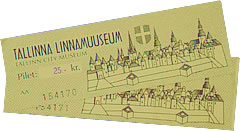
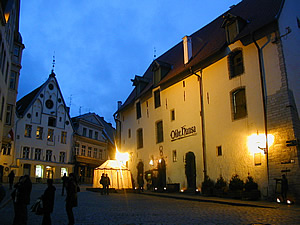
South of the museum, past the old Dominican Monastery, is Katariina Kaik - Catherine's Passage, named for St. Catherine's Church, the remnants of which are at the north end of the passage. It is a very old alleyway leading east to a good stretch of the city walls. We found a great restaurant here: Contravento. It is a converted seventeenth century granary with a café and roaring fire downstairs and a restaurant upstairs. We ate in the restaurant twice, the first time having excellent pizzas, the second pasta for Andrew and pork for me - equally good.
Heading back into the Town Square at the bottom of Vene there is the Olde Hansa Restaurant, offering medieval "banquets". This kind of thing does not appeal to us at all but the building looks nice at night.
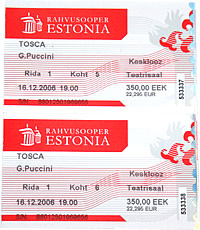
We had managed to get tickets for Tosca at Rahvusooper before travelling. A very enjoyable, dramatic opera, especially the end when she jumps from the balcony!
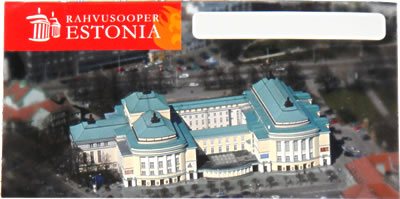
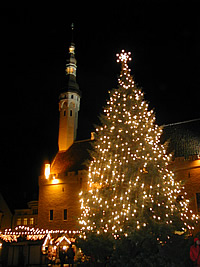
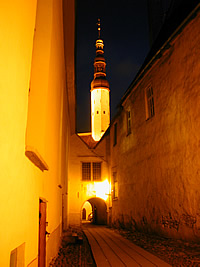
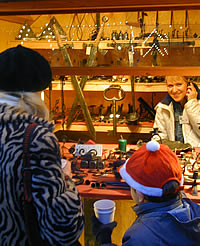
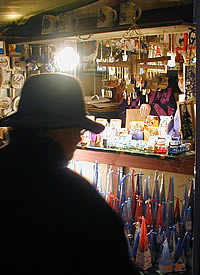
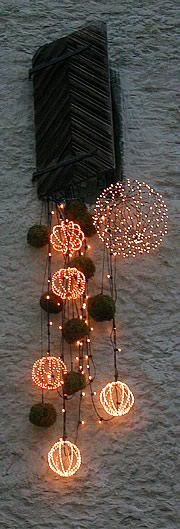
Again and again on our explorations we crossed the square, drinking many a hot wine and enjoying all the Christmas stalls. Best at night when the lights shine against the dark skyline and the crowds come out to enjoy the Christmas spirit.
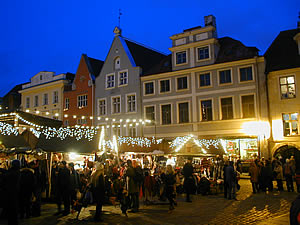
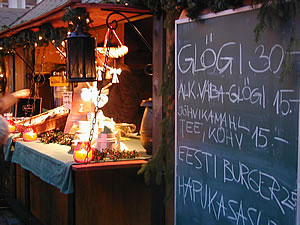
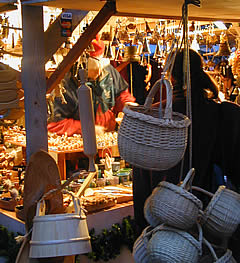
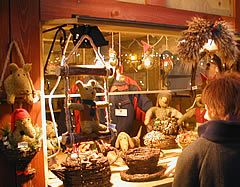
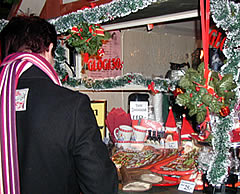
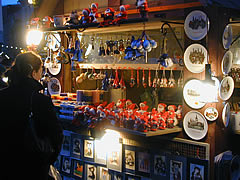
We enjoyed Tallinn greatly, its beautiful medieval buildings and city wall, food and friendly people and its great Christmas Market.
